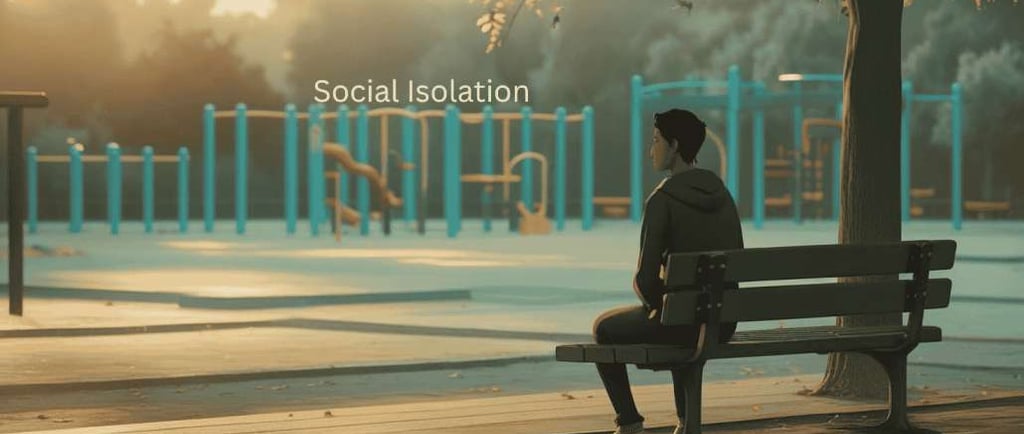Loneliness & Chronic Illness in Older Adults
Explore how social isolation impacts the mental and physical health of older adults with chronic illnesses. Learn evidence-based strategies to reduce loneliness, improve wellbeing, and foster social connection.
HEALTH & AWARNESS
Tapas Kumar Basu
6/11/20257 min read


Table of Contents
Introduction
Understanding Social Isolation vs. Loneliness
Prevalence of Social Isolation Among Older Adults with Chronic Illnesses
Mental Health Consequences of Social Isolation
Physical Health Consequences of Social Isolation
Strategies to Reduce Social Isolation in Older Adults with Chronic Illnesses
The Role of Healthcare Professionals and Policymakers
Conclusion
References
Introduction
As people age, maintaining strong social connections becomes increasingly vital for their health and quality of life. Unfortunately, many older adults particularly those living with chronic illnesses face heightened risks of social isolation. Reduced mobility, health-related limitations, and the loss of close friends or spouses can lead to a lack of regular social interaction.
Social isolation is more than just a social concern; it is a public health issue with serious consequences. In this article, we explore the prevalence and impact of social isolation on older adults with chronic illnesses. We also highlight actionable strategies to reduce isolation and improve the mental and physical health of this vulnerable population.
Understanding Social Isolation vs. Loneliness
It’s essential to differentiate between social isolation and loneliness:
Social isolation is the objective lack of social contact or interaction.
Loneliness is the subjective feeling of being alone, regardless of the actual social situation.
Though distinct, the two often overlap and can reinforce one another. Some older adults may live alone but feel connected and fulfilled, while others surrounded by people might still feel lonely.
According to the National Institute on Aging, approximately 28% of older adults in the U.S. live alone, with a significant number facing both isolation and loneliness. Factors contributing to isolation in this age group include:
Retirement and reduced work-related interaction
Mobility issues and chronic pain
Loss of spouse or close friends
Sensory impairments (e.g., hearing or vision loss)
Transportation barriers
Prevalence of Social Isolation Among Older Adults with Chronic Illnesses
Chronic illnesses such as diabetes, cardiovascular disease, arthritis, COPD, and dementia often exacerbate social isolation. These conditions may limit mobility, cause fatigue, or require complex daily care routines, making it harder to engage in social activities.
Research from the Journal of Aging Research indicates that individuals with multiple chronic conditions experience higher levels of social disconnectedness and loneliness compared to their healthier peers. Isolation in this group isn’t merely a symptom of aging it’s often a side effect of the disease process itself.
Moreover, those managing chronic conditions may also face stigma or embarrassment, especially if the illness affects their appearance or independence. As a result, some individuals may withdraw from social situations, reinforcing a cycle of isolation.
Mental Health Consequences of Social Isolation
Social isolation can severely impact the mental health of older adults, especially those managing long-term illnesses. These effects include:
1. Depression and Anxiety
The absence of meaningful connections often leads to sadness, hopelessness, and a lack of purpose. The World Health Organization (WHO) estimates that up to 14% of adults aged 60 and over experience a mental disorder, with depression being the most common.
2. Increased Stress and Emotional Distress
Without a support system, older adults may feel overwhelmed by their health challenges, leading to chronic stress, which further deteriorates both mental and physical health.
3. Cognitive Decline and Dementia Risk
Social interaction provides critical mental stimulation. Studies show that isolated seniors have a 50% higher risk of developing dementia compared to those with active social lives (Holt-Lunstad et al., 2015).
4. Poor Sleep Quality
Research by Hawkley and Cacioppo (2010) found that loneliness is associated with disrupted sleep patterns, which can negatively affect cognitive function, emotional regulation, and physical resilience.
5. Reduced Coping Ability
Those with limited social support may struggle to manage their chronic illness, increasing their risk of psychological breakdowns or reduced adherence to treatment plans.
6. Lower Life Satisfaction
Socially isolated seniors often report lower levels of happiness, self-esteem, and a reduced sense of purpose. This diminished life satisfaction is strongly correlated with poor overall health outcomes.
7. Heightened Risk of Suicidal Ideation
Older adults who experience prolonged loneliness may develop feelings of worthlessness or believe they are a burden, leading to increased suicidal thoughts or behaviors. Studies show that suicide rates are highest among adults aged 85 and older, often linked to isolation and undiagnosed depression.
8. Development of Negative Thought Patterns
Lack of social engagement often fosters rumination, self-blame, and catastrophic thinking. These repetitive negative thought patterns reinforce depressive and anxious states, making recovery more difficult without external social input.
9. Increased Vulnerability to Substance Misuse
In the absence of meaningful relationships, some isolated seniors may resort to alcohol, prescription medication, or even illicit drugs as a coping mechanism to deal with emotional pain, boredom, or sleep disturbances.
10. Emotional Numbness and Apathy
Prolonged disconnection can lead to flattened emotional responses, where individuals become disengaged from activities and people they once enjoyed. This emotional blunting often coexists with chronic stress and depressive symptoms.
11. Heightened Risk of Psychosomatic Symptoms
Social isolation can manifest mentally in the form of psychosomatic symptoms such as headaches, digestive issues, or chest pain that have no medical cause but are triggered by psychological distress and anxiety.
Physical Health Consequences of Social Isolation
While social isolation is often discussed in terms of mental health, its effects on physical health are just as profound and potentially life-threatening.
1. Cardiovascular Disease
Chronic loneliness and stress are linked to high blood pressure, inflammation, and increased risk of stroke and heart attack.
2. Weakened Immune Function
Isolated individuals exhibit weaker immune responses, making them more susceptible to infections and slower recovery times (Cacioppo et al., 2015).
3. Poor Nutrition
Older adults who live alone or lack support may experience difficulty preparing meals or may lose interest in eating altogether, leading to malnutrition or nutrient deficiencies.
4. Increased Mortality
Social isolation can raise the risk of premature death by 26–29%, a rate comparable to the health risks of smoking or obesity (Holt-Lunstad et al., 2015).
5. Exacerbation of Chronic Pain
Pain perception increases when emotional support is lacking. This can lead to greater reliance on pain medication or reduced physical functioning (Molton & Terrill, 2014).
6. Reduced Physical Activity
Without encouragement or companionship, isolated seniors may be less likely to engage in physical activity, which is critical for managing chronic diseases and maintaining mobility.
7. Fall Risk and Hospitalization
A sedentary lifestyle combined with poor balance and muscle weakness increases the risk of falls, which are a leading cause of injury among the elderly.
8. Delayed Medical Treatment
Isolated individuals may lack someone to encourage or assist them in seeking timely medical care, leading to worsened health outcomes or preventable emergencies.
9. Sleep Disorders and Circadian Rhythm Disruption
Social isolation has been linked to insomnia, fragmented sleep, and disrupted circadian rhythms, which are crucial for cellular repair, immune function, and cognitive health. Poor sleep increases vulnerability to various chronic diseases, including diabetes and cardiovascular conditions.
10. Higher Risk of Functional Decline
Older adults who are socially isolated tend to show faster declines in activities of daily living (ADLs) such as dressing, bathing, and walking. This loss of independence often accelerates the need for assisted living or nursing home care.
11. Worsening of Respiratory Conditions
Research suggests that loneliness and chronic stress can aggravate respiratory illnesses like chronic obstructive pulmonary disease (COPD) and asthma. Stress-induced inflammation and reduced adherence to medication regimens contribute to more frequent exacerbations and hospital visits.
Strategies to Reduce Social Isolation in Older Adults with Chronic Illnesses
Combating isolation requires a multifaceted, community-based approach that involves caregivers, families, health professionals, and policy makers.
1. Foster Regular Social Engagement
Encourage participation in senior clubs, religious groups, or hobby circles.
Promote intergenerational activities to build purpose and connection.
Schedule routine visits or calls from family and friends.
2. Leverage Technology for Connection
Train older adults in using video calls, messaging apps, and social media.
Provide access to tablets, smartphones, or easy-to-use communication devices.
Support online support groups or virtual meetups tailored to chronic illness communities.
3. Provide Home and Community Support Services
Services like meal delivery, transportation, and home healthcare allow seniors to maintain independence while reducing the burdens that contribute to isolation.
4. Mental Health Support
Offer accessible counseling, group therapy, and peer support for those managing chronic illness and loneliness.
Incorporate mental health check-ins during routine medical appointments.
5. Promote Physical Activity with a Social Component
Encourage group exercises such as tai chi, walking clubs, or chair yoga.
Physical activity not only boosts health but creates opportunities for social interaction.
6. Encourage Purpose-Driven Activities
Involve seniors in volunteering, mentoring, or arts and crafts to rekindle a sense of contribution.
Help them rediscover hobbies they previously enjoyed.
7. Educate Caregivers and Families
Help caregivers understand the signs of social isolation and provide them with resources to engage and support their loved ones.
Encourage them to include the older adult in family events and everyday conversations.
8. Develop Age-Friendly Communities
Support urban planning that prioritizes walkability, accessible public spaces, and transportation.
Advocate for community centers and libraries to offer programming that brings people together.
9. Integrate Social Prescribing into Healthcare
Encourage healthcare providers to use social prescribing, where patients are referred to community groups, art classes, or volunteering activities as part of their care plan.
· This holistic approach recognizes that non-clinical interventions can significantly improve mental wellbeing and reduce isolation.
10. Establish Peer Companionship Programs
Implement buddy systems or senior-to-senior visitation programs where older adults are paired with peers for regular interaction.
Peer companionship builds mutual understanding, reduces stigma around aging, and improves long-term emotional health.
11. Collaborate with Faith-Based and Cultural Organizations
Partner with churches, mosques, temples, and cultural centers to offer inclusive events and support tailored to specific communities.
These organizations often have existing trust and outreach mechanisms that can be leveraged to reconnect isolated elders.
The Role of Healthcare Professionals and Policymakers
Healthcare professionals must be trained to screen for social isolation and mental health concerns during regular check-ups. Simple questions about recent social activity, mood, and living conditions can help identify at-risk individuals.
Public policy must also reflect the urgency of this issue. Governments can:
Fund local community centers and senior programs
Promote digital literacy and internet access for older adults
Support caregiver education and respite care programs
Integrate social care into chronic disease management models
Conclusion
While social isolation poses challenges to the mental and physical health of older adults with chronic illnesses, it is also an opportunity an invitation to create meaningful change. With the right mix of community support, technology, and compassionate care, we can help seniors reconnect, thrive, and live fuller, healthier lives.
By fostering strong social bonds and empowering older adults to stay engaged, families, healthcare providers, and communities can transform isolation into connection and loneliness into belonging. Together, we have the power to enhance wellbeing, boost resilience, and enrich the quality of life for our aging population making the golden years truly shine.
References
Holt-Lunstad, J., Smith, T. B., & Layton, J. B. (2015). Social relationships and mortality risk: A meta-analytic review. PLoS Medicine, 12(7), e1001870.
National Institute on Aging. (n.d.). Social isolation, loneliness in older people pose health risks.
World Health Organization. (2017). Mental health of older adults.
Cacioppo, J. T., & Cacioppo, S. (2015). Social relationships and health: The toxic effects of perceived social isolation.
Hawkley, L. C., & Cacioppo, J. T. (2010). Loneliness matters: A theoretical and empirical review of consequences and mechanisms.
Molton, I. R., & Terrill, A. L. (2014). Overview of persistent pain in older adults.
Keller, H. H., & Ostbye, T. (2013). Nutrition and aging.
Explore fitness, meditation, and healthy living tips.
© 2025. All rights reserved.
